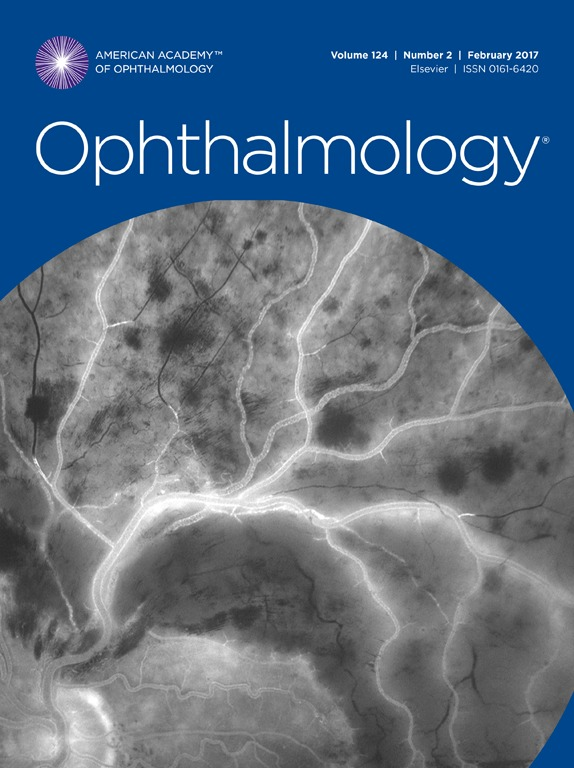与玻璃体内抗血管内皮生长因子单克隆抗体相关的心脑血管不良事件:世界卫生组织药物警戒研究。
IF 13.1
1区 医学
Q1 OPHTHALMOLOGY
引用次数: 0
摘要
目的:分析玻璃体内抗血管内皮生长因子(VEGF;aflibercept、贝伐单抗、brolucizumab和ranibizumab)治疗后的心脑血管不良事件(ADRs):世界卫生组织(WHO)全球安全报告数据库 VigiBase 设计:药物警戒研究 方法:将玻璃体内抗血管内皮生长因子治疗后心脑血管 ADR 的单个病例安全报告(ICSR)与完整数据库中的报告进行比较。从 2004 年到 2023 年,玻璃体内抗 VEGF 治疗后的 ADR 为 23,129 例,与任何药物相关的 ADR 为 25,015,132 例(完整数据库):计算报告几率(ROR)和信息成分(IC),并使用信息成分的 95% 可信区间下限(IC025)进行贝叶斯不对称报告。使用奇异比(rOR)进行药物间比较:77])、心律失常,包括心房颤动、心房扑动、心室颤动、室上性心动过速(IC025 均>0,ROR>1)、高血压(IC025 2.22;ROR:4.91 [95% CI 4.82-5.01])和高血压危象(IC025 1.97;ROR:4.49 [95% CI 4.07-4.97])。此外,抗血管内皮生长因子与较高的脑血管 ADR 相关,如脑梗塞(IC025 4.34;ROR:23.19 [95% CI 22.10-24.34])、颈动脉狭窄(IC025 1.85;ROR:5.24 [95% CI 3.98-6.89])、脑出血(IC025 2.29;ROR:5.38 [95% CI 5.03-5.76])和蛛网膜下腔出血(IC025 1.98;ROR:4.81 [95% CI 4.14-5.6])。药物间比较显示,与雷尼珠单抗相比,使用阿夫利百普的患者在心肌梗死等心脑血管 ADRs 方面总体报告不足(rOR 0.55 [95% CI 0.49-0.52])、心房颤动(rOR 0.28 [95% CI 0.23-0.35])、脑血管意外(rOR,0.15 [95% CI 0.14-0.17])和脑出血(rOR,0.51 [95% CI 0.40-0.65]):在这项药物警戒病例-非病例研究中,发现玻璃体内抗血管内皮生长因子治疗后心血管和脑血管不良反应的报告显著增加。虽然雷尼珠单抗的生物特性可能显示出更高的全身安全性,但考虑到其报告率高于贝伐珠单抗或阿弗利贝赛普,因此不应忽视心脑血管不良反应的发生。本文章由计算机程序翻译,如有差异,请以英文原文为准。
Cardiovascular and Cerebrovascular Adverse Events Associated with Intravitreal Anti-VEGF Monoclonal Antibodies
Purpose
To analyze cardiovascular and cerebrovascular adverse drug reactions (ADRs) after intravitreal anti–VEGF (aflibercept, bevacizumab, brolucizumab, and ranibizumab) treatment.
Participants
VigiBase, a World Health Organization (WHO) global safety report database.
Design
Pharmacovigilance study.
Methods
The individual case safety reports (ICSRs) of cardiovascular and cerebrovascular ADRs after intravitreal anti-VEGF treatment were compared with those reported in the full database. From 2004 to 2023, there were 23 129 ADRs after intravitreal anti-VEGF therapy and 25 015 132 ADRs associated with any drug (full database).
Main Outcome Measures
The reporting odds ratio (ROR) and information components (ICs) were calculated, and the 95% lower credibility interval end point of the information component (IC025) was used for disproportionate Bayesian reporting. Inter-drug comparisons were performed using the ratio of odds ratio (rOR).
Results
Compared with the full database, anti-VEGFs were associated with an increased reporting of myocardial infarction (IC025 0.75; ROR: 1.78 [95% CI, 1.70–1.86]), angina pectoris (IC025 0.53; ROR: 1.61 [95% CI, 1.47–1.77]), arrhythmias including atrial fibrillation, atrial flutter, ventricular fibrillation, supraventricular tachycardia (all IC025 > 0, ROR>1), hypertension (IC025 2.22; ROR: 4.91 [95% CI, 4.82–5.01]), and hypertensive crisis (IC025 1.97; ROR: 4.49 [95% CI, 4.07–4.97]). Moreover, anti-VEGFs were associated with a higher reporting of cerebrovascular ADRs such as cerebral infarction (IC025 4.34; ROR: 23.19 [95% CI, 22.10–24.34]), carotid artery stenosis (IC025 1.85; ROR: 5.24 [95% CI, 3.98–6.89]), cerebral hemorrhage (IC025 2.29; ROR: 5.38 [95% CI, 5.03–5.76]), and subarachnoid hemorrhage (IC025 1.98; ROR: 4.81 [95% CI, 4.14–5.6]). Inter-drug comparison indicated that compared with ranibizumab, patients receiving aflibercept showed overall under-reporting of cardiovascular and cerebrovascular ADRs such as myocardial infarction (rOR 0.55 [95% CI, 0.49–0.52]), atrial fibrillation (rOR 0.28 [95% CI, 0.23–0.35]), cerebrovascular accident (rOR, 0.15 [95% CI, 0.14–0.17]), and cerebral hemorrhage (rOR, 0.51 [95% CI, 0.40–0.65]).
Conclusions
In this pharmacovigilance case-noncase study, there was significantly increased reporting of cardiovascular and cerebrovascular ADRs after intravitreal anti-VEGF treatment. Although ranibizumab may exhibit superior systemic safety regarding its biological characteristics, it is crucial not to overlook the occurrence of cardiovascular and cerebrovascular ADRs considering its higher reporting rate than bevacizumab or aflibercept.
Financial Disclosure(s)
The author(s) have no proprietary or commercial interest in any materials discussed in this article.
求助全文
通过发布文献求助,成功后即可免费获取论文全文。
去求助
来源期刊

Ophthalmology
医学-眼科学
CiteScore
22.30
自引率
3.60%
发文量
412
审稿时长
18 days
期刊介绍:
The journal Ophthalmology, from the American Academy of Ophthalmology, contributes to society by publishing research in clinical and basic science related to vision.It upholds excellence through unbiased peer-review, fostering innovation, promoting discovery, and encouraging lifelong learning.
 求助内容:
求助内容: 应助结果提醒方式:
应助结果提醒方式:


